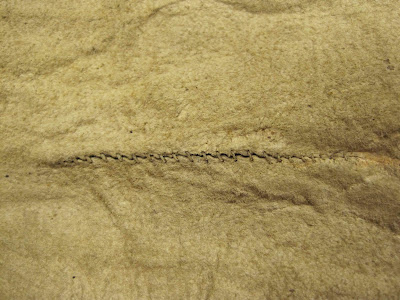 |
| Heather Richardson and Andrew Hughes, PRM Conservators, gently folding one of the Blackfoot shirts as the exhibition is dismantled. |
I am very
sad that the Blackfoot Shirts exhibition has ended. Since February I have
enjoyed watching visitors in the exhibition and reading their comments: many
comments are unusually long for visitor book comments, thoughtful, and reflecting
the emotional qualities of the quotes and photographs. It has been gratifying
to see the project having an impact on people in Britain and around the world
(our visitorship is international). It has also been a steadying influence for
me to see the ancestors many times a day. The exhibition space is visible from
the main staircase in the Pitt Rivers Museum, and on the main corridor between
the stairs and the tearoom and staff entrance, so every day I have walked past
the gallery and paused to acknowledge the ancestors and the work they are
doing. It has been such a blessing to work on this project, and as I pass the
shirts, I say thank you to the ancestors, every single time. They also remind
me—with their intense physical and spiritual presence—that they are sacred
objects and that there are Blackfoot protocols for behavior around sacred
objects. If I have been angry or
frustrated, just a glimpse of the shirts has made me think about that, and let
go of it and be calmer and grateful as I move past them. Those of us who work
across cultures are changed by the experiences, by what we learn from others.
Sometimes I have sat on the bench outside the gallery and just taken in their
presence, and on occasion I have asked for their strength and help on a really
tough day. I’m going to miss seeing them.
And hearing
them. Narcisse Blood’s video, an important part of the exhibition, includes the
voices of Blackfoot friends and family and mentors, as well as Alison Brown and
myself reflecting on the project. There’s an honor song sung by Troy Twigg;
Narcisse’s gentle voice speaking in Blackfoot to the ancestors; Ramona Bighead
and Delia Crosschild reflecting on the project; and many giggling high school
students. The sound has gently permeated the museum space, the tea room where
we have lunch, and provides an almost-but-not-quite-inaudible background to
teaching in the lecture theatre: it’s like all these people are with us all the
time. I know they are as well even without the exhibition. I’ll just have to
work harder at reminding myself.
On Monday,
just before my colleagues begin to dismantle the exhibition, I will thank the
ancestors for their work and tell them what is happening next. I will have to
do this in English, but hope they understand what is in my heart, what my
meaning is. I will say thank you for teaching English people about Blackfoot
people and about why you are still important to your great-great-grandchildren.
Thank you for reaching out to visiting First Nations and Native American people
who identified themselves in the guest book. Thank you for touching the hearts
and minds of so many people from so many different cultures. Thank you for your
generosity and your strength. Thank you for teaching us here at the Pitt Rivers
Museum, so many things. Thank you for making our relationships stronger with
each other and with everyone involved in the project.
There have
been, as Delia Cross Child said, so many ripples from this project. One of them
is that I no longer worry that my museum colleagues will think I am bonkers
when I speak out loud to the shirts. The colleagues in the room with me on
Monday will include Heather Richardson, who came to Alberta to help with the
handling sessions and who developed strong relationships with Blackfoot people
as well—she speaks to the ancestors when she works with them too. Technical
services colleagues, who were painted by Alvine Mountain Horse in the
exhibition space, will be part of the team. Other colleagues have listened to
Blackfoot mentors during visits to the Pitt Rivers over the years. I’m not the
only one who will be sad to see this exhibition come down.
And what
will I say to the ancestors about what is happening next? I will say that we
are removing them from display to give them a physical rest. I will say that
the book about the project is at press and that they will continue to teach
through the book and the website. And I will remind them that their people have
asked them to come home for a longer visit, and that this has been agreed—we
just have to figure out the logistics and funding. I will remind them that
their work has triggered another project, run by Alison Brown, which will see a
Blackfoot delegation come to the UK this autumn to view collections at other
museums. This is farewell, for a time, but certainly not the end.
I’ll miss
them terribly, though.




